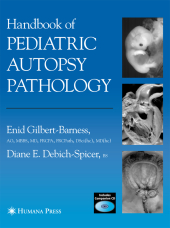 Neuerscheinungen 2010Stand: 2020-01-07 |
Schnellsuche
ISBN/Stichwort/Autor
|
Herderstraße 10
10625 Berlin
Tel.: 030 315 714 16
Fax 030 315 714 14
info@buchspektrum.de |

Diane E. Debich-Spicer, Enid Gilbert-Barness
(Beteiligte)
Handbook of Pediatric Autopsy Pathology
2005. 2010. xiv, 532 S. 966 SW-Abb., 1 Farbabb. 279 mm
Verlag/Jahr: SPRINGER, BERLIN 2010
ISBN: 1-61737-433-4 (1617374334)
Neue ISBN: 978-1-61737-433-3 (9781617374333)
Preis und Lieferzeit: Bitte klicken
Pathologists have long recognized that the pediatric autopsy requires great care in technique and dissection to ensure that easily overlooked malformations are recognized and accurate diagnoses are made. Working in the tradition of the master pediatric pathologists, the highly experienced practitioners Enid Gilbert-Barness, MD, and Diane E. Debich-Spicer have created in the Handbook of Pediatric Autopsy Pathology a comprehensive reference guide to the successful performance of pediatric autopsies and the optimal recognition and interpretation of their pathologic findings. The authors cover such major developmental disorders as hydrops, chromosomal defects, congenital abnormalities, and metabolic disorders. The reviews of the organ systems encompass the cardiovascular, respiratory, gastrointestinal, renal, central nervous, and skeletal systems, plus the male and female genitourinary systems, the eye and adnexa, and the thymus, spleen, lymph nodes, and immunodeficiency. Additional chapters address sudden infant death, cytogenetics, the medical and forensic autopsy, special procedures, cultures and infection control, and biological hazards at the autopsy. Numerous standard reference tables, copious illustrations and drawings, and an appendix at the end of each chapter provide a wealth of practical information and bibliographic citations. A value-added compact disk provides color versions of over 400 selected illustrations found in the book.
Cutting-edge and detailed, the Handbook of Pediatric Autopsy Pathology offers the prosector unequaled guidance to performing a pediatric autopsy, making an accurate diagnosis, and-where malformations are involved-explaining the implications of possible recurrences in future pregnancies. A comprehensive reference guide to the successful performance of pediatric autopsies and to the optimal recognition and interpretation of their pathologic findings. The authors cover such major developmental disorders as hydrops, chromosomal defects, and congenital abnormalities, metabolic disorders, and review the major organ systems. Additional chapters address sudden infant death, cytogenetics, the medical and forensic autopsy, special procedures, cultures and infection control, and biological hazards at the autopsy. Numerous standard reference tables, copious illustrations and drawings, and an appendix at the end of each chapter provide a wealth of practical information and bibliographic citations.
Part I: General Principles
General Principles
Part II: Techniques
Pediatric Autopsy: Fetus, Newborn, and Child
Examination of the Human Embryo
The Placenta
Part III: Developmental Disorders
Hydrops
Chromosomal Defects
Congenital Abnormalities
Part IV: Organ Systems and Metabolic Disorders
Cardiovascular System
Respiratory System
Gastrointestinal System
Liver, Gallbladder, Biliary Tract, and Pancreas
Renal System
Male and Female Genitourinary Systems
Central Nervous System
Thymus, Spleen, Lymph Nodes, and Immunodeficiency
Skeletal System
Eye and Adnexa Sectioning
Metabolic Diseases
Part V: Special Considerations
Sudden Infant Death
Pediatric Forensic Pathology
Special Procedures
Infection Control and Biological Hazards in the Autopsy
Index


